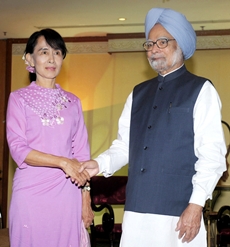|
The trilateral highway connecting India, Myanmar and Thailand will be fully built by the year 2016, heralding a new era of cooperation and economic integration of the region, Prime Minister Manmohan Singh said today.  Addressing intellectuals and members of business community in the Myanmarese capital of Yangoon, Manmohan Singh said ''better communication is the best way of promoting economic integration and there is much we can do to revive and build arteries of communication.'' Addressing intellectuals and members of business community in the Myanmarese capital of Yangoon, Manmohan Singh said ''better communication is the best way of promoting economic integration and there is much we can do to revive and build arteries of communication.''
He said the two governments have agreed to cooperate in a number of road building projects. ''I hope that the very symbolic Trilateral Highway that will connect India, Myanmar and Thailand can be fully built by 2016.'' Myanmar is a critical partner in India's ''Look East'' policy and is perfectly situated to play the role of an economic bridge between India and China and between South and South-East Asia, Manmohan Singh said. Manmohan Singh said India and Myanmar should work together to create a regional economy that can become a hub for trade, investment and communication in the region. India is also implementing the Kaladan multimodal transport project that involves upgrading the Sittwe port and constructing a highway to connect the town of Paletwa in Chin state of Myanmar to the Indian border in Mizoram. ''This flagship project will revitalise the economy of the area and link it with important commercial and shipping arteries. We hope to complete it by 2015,'' he said. Initiatives like the Bay of Bengal Initiative for Multi-Sectoral Technical and Economic Cooperation (BIMSTEC) and Mekong Ganga Cooperation provide a platform for enhanced regional cooperation and connectivity, he said, adding that the two countries have also agreed to cooperate in the development of the border regions. BIMSTEC provides a unique link between South Asia and Southeast Asia bringing together 1.3 billion people - 21 per cent of the world population, a combined GDP of $750 billion, and a considerable amount of complementarities. A study shows the potential of $43 billion to $59 billion trade creation under BIMSTEC FTA. BIMSTEC covers 14 priority sectors lead by member countries in a voluntary manner, namely, trade and investment, technology, energy, transport and communication, tourism, fisheries, agriculture, cultural co-operation, environment and disaster management, public health, people-to-people contact, poverty alleviation and countering terrorism and transnational crimes. India will assist Myanmar in the development of two areas contiguous to its border, namely the Naga Self Administered Zone of the Sagaing Region and the Chin state. India hopes to replicate small development projects that have been successful elsewhere in those areas. The two countries have, meanwhile, agreed to set up several border markets, beginning with the one at Pangsau, on the border of Arunachal Pradesh in India and Sagaing in Myanmar. ''We are working to develop border infrastructure, including the Rhi-Tiddim road that will enable greater cross-border links and trade between Mizoram and Chin state,'' Manmohan Singh said. These efforts will give a boost to the local economies and provide livelihood opportunities. Trade will expand and be brought within the ambit of the law. These measures will also help curb the activities of insurgent groups and other criminal elements in these areas, the prime minister noted. He said in order to exploit the full potential of the economic relationship, the two countries need to facilitate trade and investment. As a fist step, United Bank of India is in the process of opening its representative office in Myanmar to streamline bilateral banking arrangements and to ease financial transactions.
India has already extended a $500 million line of credit to Myanmar to jumpstart commercial transactions. India hopes to surpass bilateral trade target with Myanmar of $3 billion by the year 2015. But, Manmohan Singh said, the two countries have to diversify their trade basket. India can import more agricultural produce, coal and other minerals and export heavy industrial items, chemicals, pharmaceuticals and textiles, he said.
|